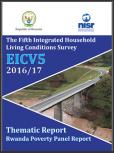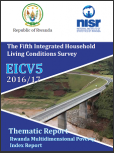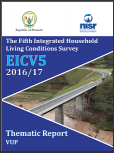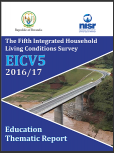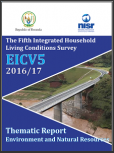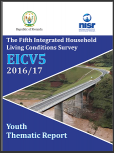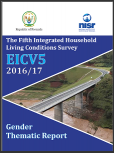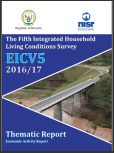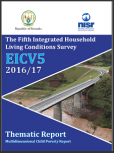The Fifth Integrated Household Living Conditions Survey or Enquête Intégrale sur les Conditions de Vie des ménages (EICV 5) in french, provides information on changes in the well-being of the population such as poverty, inequality, employment, living conditions, education, health and housing conditions, household consumption, among others in 2016/17. EICV5 dataset can be accessed through http://microdata.statistics.
Publications
EICV5 Power Point Presentation
Results of EICV5 were disseminated on 6th December 2018 at Kigali Convetion Centre.
EICV5_Poverty Panel Report
The Report focuses on four basic questions:
EICV5_Thematic Report_Multidimensional Poverty Index_MPI
This report presents Rwanda’s Multidimensional Poverty Index (MPI) which is based on EICV data. The analysis of Rwanda MPI used four dimensions with corresponding 14 indicators:
EICV5-Thematic Report-VUP
The VUP program (Vision 2020 Umurenge Programme), run by the Ministry of Local Government, is the main social protection programme in Rwanda.
EICV5_Thematic Report_Education
The purpose of this report is to present, analyze and interpret the data collected from the 2016/2017 EICV5 to enable assessment of the progress made in the education sector in the last three years. It presents data on education attendance, education attainment, literacy, access to primary and secondary education while attempting to identify factors which affect these education levels. Further, the report also probes access to technical, vocational and higher learning education.
EICV5_Thematic Report_ENR
This report presents and discusses results of EICV5 and compares them with the results that were generated in EICV4. It focuses on the areas of human settlement and the environment, energy and water resources, land management and environment related problems. In this report, most of tables provide results both for EICV4 and EICV5 and highlight developments over time. They also discuss different patterns across the provinces in Rwanda and in urban and rural areas.
EICV5_Thematic Report_Youth
This report presents and discusses detailed results from EICV5. It focuses on youth and compares EICV5 and EICV4 in the areas of demography, education, Information and Communication Technology, economic activity, poverty and migration. Most of tables provide the results on youth population from both EICV5 and EICV4 and help to explore trend over time, as well as different patterns across the provinces, urban and rural areas of Rwanda.
EICV5_Thematic Report_Gender
In this report, the majority of tables provide results for both EICV4 and EICV5 and highlight developments over time, as well as different patterns across provinces in Rwanda, both in urban and rural areas. Emphasis has been placed on including disaggregated results for men and women and male and female-headed households to explore gender-related aspects in key social and economic characteristics of persons and households in Rwanda, as well as other types of disaggregation, such as age group, type of habitat, etc. Where necessary, districts tables have been provided in annex.
EICV5_Thematic Report_Economic activity Thematic Report.pdf
The present report is one of six thematic reports produced from EICV5.
EICV5-Thematic Report-Multidimensional Child Poverty Report
The Multidimensional child poverty analysis, 2016/17 used data from EICV and focused on children aged 5 to 14 and 15 to 17 years. Assessing the current challenges from a child’s point of view offers important insights on the nature of poverty in Rwanda – who are the poor, why their poverty persists, and how poverty is inter-generationally transmitted.


